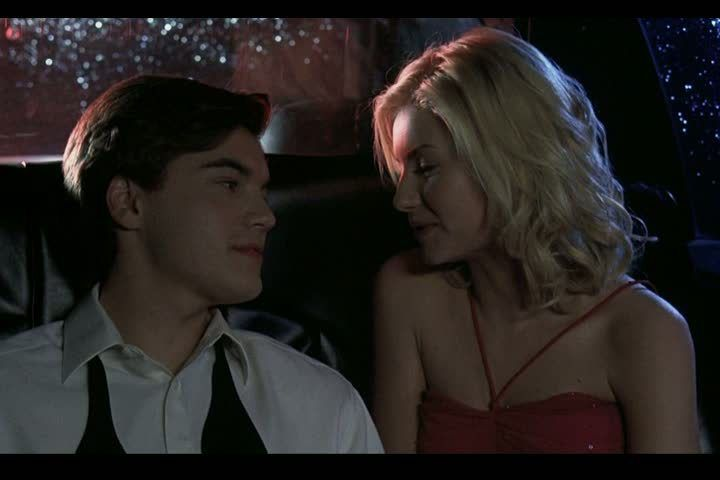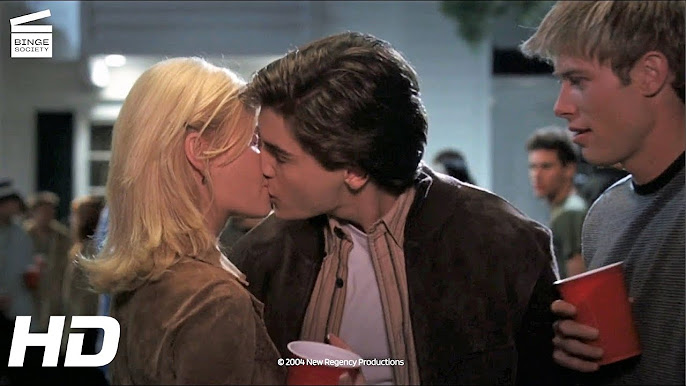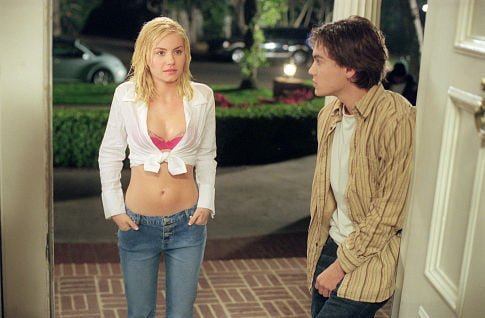The Girl Next Door

Introducing The Girl Next Door (2004) – A Comprehensive Overview
*** with Heart and Edge
The Girl Next Door (2004), directed by Luke Greenfield, is an American teen romantic comedy that blends ***, heartfelt romance, and a subversive twist on the coming-of-age genre. Starring Elisha Cuthbert as Danielle, a ***, and Emile Hirsch as Matthew, a high school senior drawn into her world, the film explores themes of love, ambition, and societal judgment. With a supporting cast including Timothy Olyphant, Chris Marquette, and Paul Dano, it balances crude gags with emotional depth, drawing comparisons to Risky Business (1983). Released on April 9, 2004, by 20th Century Fox, The Girl Next Door received mixed reviews but grossed over $30 million worldwide, gaining a cult following for its bold premise and Cuthbert’s star-making performance. This article provides a comprehensive exploration of the film’s narrative, cast, production, themes, reception, and cultural significance, offering a complete introduction to its enduring appeal.

Synopsis: A Teen Romance with a Dangerous Twist
Set in a suburban American town in the early 2000s, The Girl Next Door follows Matthew Kidman (Emile Hirsch), an ambitious high school senior focused on his college scholarship and a speech competition to secure his future at Georgetown University. His orderly life is upended when Danielle (Elisha Cuthbert), a beautiful 19-year-old, moves in next door to live with her aunt. Matthew, a studious “good boy,” is instantly smitten, and their flirtation escalates after a daring ***. Their budding romance, filled with playful chemistry, takes Matthew out of his comfort zone, as Danielle encourages him to embrace spontaneity, leading to moments like sneaking into a school dance and a passionate kiss at a party.
The narrative shifts when Matthew’s friend Eli (Chris Marquette), a porn enthusiast, reveals Danielle’s secret: she’s a ***. Shocked, Matthew confronts her, causing a rift, but his feelings persist. Danielle, seeking a fresh start, is drawn back into her past by her former producer, Kelly (Timothy Olyphant), a volatile hustler who arrives to exploit her. Kelly manipulates Matthew into dangerous schemes, including a *** in Las Vegas to secure funding for a scholarship scam. As Matthew navigates Kelly’s threats and Danielle’s world, he grapples with his own desires and moral compass, enlisting Eli and his nerdy friend Klitz (Paul Dano) to outwit Kelly.
The climax involves a high-stakes plan to steal a *** from Kelly during his visit to Matthew’s school, leading to a comedic yet tense showdown. Matthew’s growth culminates in a bold speech at the scholarship event, where he defies expectations to embrace his authentic self, winning Danielle’s heart and securing his future. Running at 109 minutes (with an unrated 110-minute cut), The Girl Next Door is a spirited blend of teen comedy, romance, and thriller, delivering laughs, heart, and a subversive edge.

Elisha Cuthbert and Emile Hirsch: A Magnetic Pair
The performances in The Girl Next Door drive its charm, with Elisha Cuthbert and Emile Hirsch anchoring the romance with electric chemistry. Elisha Cuthbert, aged 21 and fresh off 24, delivers a star-making turn as Danielle. Her radiant beauty and confident allure make Danielle both enigmatic and relatable, while her vulnerability—seen in scenes confronting her past—adds depth. Critics, like Roger Ebert, praised Cuthbert’s “refreshing” presence, noting she “makes Danielle more than a fantasy figure.” Her ability to balance seductive confidence with emotional honesty, as in the skinny-dipping scene, earned Variety’s accolade as a “revelation,” cementing her as a 2000s icon.
Emile Hirsch, as Matthew Kidman, brings a boyish earnestness to the straight-laced senior, his wide-eyed wonder and nervous energy capturing a teen on the cusp of adulthood. Hirsch’s comedic timing, particularly in awkward moments like his speech prep, and his dramatic shift to defiance against Kelly, impressed The New York Times, which called him “endearingly authentic.” His chemistry with Cuthbert, described by Letterboxd users as “palpable,” fuels the romance, making their love believable despite the film’s wild premise.
Timothy Olyphant, as Kelly, steals scenes with a manic, menacing charisma, his unpredictable energy elevating the villain role. Entertainment Weekly lauded Olyphant’s “deliciously sleazy” performance, with fans on Reddit calling him a “scene-stealer.” Chris Marquette, as Eli, and Paul Dano, as Klitz, provide comedic support, their nerdy camaraderie adding levity, though The Guardian noted their roles lean on stereotypes. Supporting performances, including James Remar as Matthew’s father and Olivia Wilde in a brief early role, enrich the suburban backdrop. The ensemble’s interplay, particularly in chaotic group scenes, balances humor and tension, with Cuthbert and Hirsch as the emotional core.

Production: A Risky Blend of Comedy and Drama
Directed by Luke Greenfield, fresh off The Animal (2001), The Girl Next Door was written by Stuart Blumberg, David T. Wagner, and Brent Goldberg, inspired by Risky Business but modernized with a 2000s teen sensibility. Produced by 20th Century Fox, New Regency, and Epsilon Motion Pictures with a $20-25 million budget, the film was shot in 2003 in Los Angeles, capturing suburban neighborhoods, high school halls, and a glitzy Las Vegas convention, per Box Office Mojo. Cinematographer Jamie Anderson used a bright, warm palette for suburban scenes and neon-drenched visuals for Vegas, creating a vibrant aesthetic, as praised by Film Threat.
Paul Haslinger’s score, paired with a pop-rock soundtrack featuring The Who’s “Baba O’Riley,” Filter’s “Take a Picture,” and David Gray’s “This Year’s Love,” enhances the film’s emotional and comedic beats, released by Lakeshore Records in 2004, per Wikipedia. Production design by Stephen J. Lineweaver, with authentic teen bedrooms and a ***, grounded the film’s heightened reality, per AllMovie. Costume design by Marilyn Vance, including Cuthbert’s iconic tank tops, reflected 2000s teen fashion, as IMDb fans note.
Challenges included securing an R rating, as Fox initially pushed for PG-13, per Variety. The film’s ***—***—required careful editing, with an unrated DVD cut restoring racier scenes, as Common Sense Media details. Casting Cuthbert, a TV star, was a gamble, but her audition, described by Greenfield in a 2004 IGN interview as “captivating,” clinched the role. The Las Vegas convention scenes, shot at a real adult expo, added authenticity but sparked minor controversy for ***, per The Guardian. Premiering at the ArcLight Hollywood on April 5, 2004, the film rode the wave of teen comedy popularity, competing with Mean Girls (2004).

Themes and Symbolism: Love, Judgment, and Coming of Age
The Girl Next Door explores themes of love, societal judgment, and coming of age, using its teen comedy framework to probe deeper issues. Matthew and Danielle’s romance challenges stereotypes, with Danielle’s porn star past symbolizing societal stigma and Matthew’s acceptance reflecting personal growth, as Roger Ebert notes. The film critiques hypocrisy, as Matthew’s peers and parents judge Danielle while ignoring their own flaws, a theme resonant with 2000s debates about sex work, per Film Comment.
Class and ambition surface in Matthew’s scholarship pursuit versus Danielle’s reinvention, with their love transcending social barriers, akin to Crazy/Beautiful (2001), previously discussed. Gender dynamics are central, with Danielle’s agency reclaiming her narrative from Kelly’s control, though some Letterboxd users criticize her initial objectification. Mental health is touched on lightly, with Matthew’s stress and Danielle’s past trauma, but the film prioritizes comedy over depth, per The Guardian. Symbolically, the “girl next door” trope is subverted, as Danielle defies the wholesome archetype, while Matthew’s speech podium represents his voice, per Variety. The porn convention, a chaotic underworld, mirrors Matthew’s loss of innocence, as AllMovie analyzes.

Reception and Controversy: A Cult Hit with Mixed Reviews
The Girl Next Door received mixed reviews, earning a 56% approval rating on Rotten Tomatoes from 164 critics and a 55/100 on Metacritic from 32, indicating “mixed or average” reception. Roger Ebert gave it three stars, calling it “surprisingly engaging” for balancing “raunch and romance,” praising Cuthbert and Hirsch. The New York Times’ A.O. Scott lauded its “sweetness” but noted a “predictable” plot, while Entertainment Weekly’s Owen Gleiberman gave it a B-, appreciating the “breezy” humor but criticizing “clichéd” supporting roles. Variety praised the “likeable” leads but found the script “uneven,” and The Guardian’s Peter Bradshaw gave it two stars, calling it “crude but sporadically charming.”
Audiences were more enthusiastic, with an 84% Popcornmeter on Rotten Tomatoes from over 100,000 ratings and a B CinemaScore. 2004 fan buzz, echoed in 2025 X posts like @2000sNostalgia, hails its “iconic” romance and soundtrack, with @FilmFan25 calling it “a guilty pleasure.” Reddit threads on r/movies praise Cuthbert’s “star power,” though some, like u/cinephile22, critique its “male fantasy” vibe. The film grossed $14.6 million domestically and $30.4 million worldwide, a modest return on its $20-25 million budget, per Box Office Mojo, boosted by strong DVD sales, per Variety.
Controversy centered on its ***, with Common Sense Media rating it 17+ for “***, language, and drug use,” warning of ***. Feminist critics, like Slant Magazine’s Ed Gonzalez, argued it reinforced “***” tropes, though others, per Film Comment, praised Danielle’s agency. The R-rated cut’s ***, restored in the unrated DVD, drew debate for pandering to male audiences, as The Guardian notes, but fans on Amazon defend its “heartfelt” core.

Cultural Significance: A 2000s Teen Comedy Staple
The Girl Next Door hit theaters during the 2000s teen comedy boom, alongside American Pie (1999) and Mean Girls (2004), tapping into a cultural fascination with raunchy yet heartfelt coming-of-age tales. Released in spring 2004, it competed with lighter fare but found an audience among teens seeking edgy romance, as The Atlantic observes. Its suburban setting and high school milieu captured early 2000s American youth culture, with flip phones and pop-punk anthems evoking nostalgia, per Reddit’s r/2000sNostalgia.
Cuthbert’s breakout role made her a teen idol, leading to House of Wax (2005), while Hirsch’s performance paved the way for Into the Wild (2007), per IMDb. Olyphant’s villainous turn foreshadowed his Justified charisma, as Variety notes. Compared to Caught (1996), previously discussed, which explores infidelity through gritty drama, The Girl Next Door uses comedic romance to probe societal judgment, both featuring bold women (Danielle, Betty) defying norms but differing in tone. The film’s influence is seen in later teen comedies like Superbad (2007), blending raunch with heart, and its cult status, fueled by streaming on Hulu and Max, endures, with 2025 X posts like @vibe_trib3 calling it “peak 2000s.”

Legacy and Availability
The Girl Next Door remains a beloved 2000s teen comedy, celebrated for Cuthbert and Hirsch’s chemistry, its daring premise, and nostalgic soundtrack, though tempered by formulaic elements and dated tropes. Its 2004 DVD and 2005 unrated Blu-ray releases, including cast commentaries and a making-of featurette, are fan favorites, per Amazon. Academic analyses in Journal of Popular Culture explore its commentary on sex work stigma, while Letterboxd reviews, like @RomComFan’s “still holds up,” affirm its enduring appeal.
As of May 23, 2025, The Girl Next Door is available for streaming on Hulu, Max, Tubi, and Prime Video (subject to regional availability), with English subtitles. Rental and purchase options exist on Amazon Video, Apple TV, Fandango at Home, YouTube, and Google Play. Physical copies are available through retailers like Amazon, Walmart, and Best Buy.

Conclusion: A Bold, Heartfelt Teen Classic
The Girl Next Door (2004) is a spirited, provocative teen comedy that blends *** with heartfelt romance, capturing the messy thrill of young love. Luke Greenfield’s direction, paired with Elisha Cuthbert and Emile Hirsch’s magnetic performances, crafts a film that’s both wildly entertaining and emotionally resonant. While its dated tropes and uneven script draw criticism, its bold premise, iconic moments, and 2000s nostalgia make it a cult classic, rewarding viewers with a daring, delightful ride.
For fans of teen comedies, romantic adventures, or early 2000s cinema, The Girl Next Door offers an unforgettable journey—one that’s as *** as the girl herself.